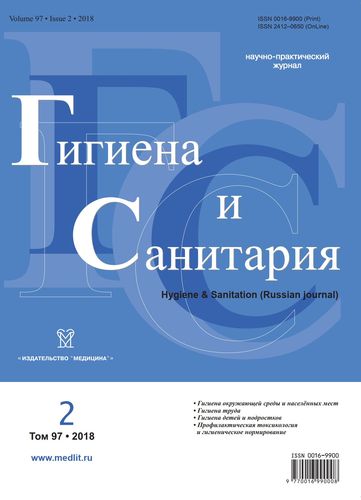Labor conditions as a factor of the risk of the occurrence of colorectal cancer
- 作者: Shirlina N.G.1, Stasenko V.L.1, Kolchin A.S.1, Antonov O.V.1, Obukhova T.M.1
-
隶属关系:
- Omsk State Medical University
- 期: 卷 97, 编号 2 (2018)
- 页面: 156-160
- 栏目: OCCUPATIONAL HYGIENE
- ##submission.datePublished##: 14.10.2020
- URL: https://vestnik.nvsu.ru/0016-9900/article/view/640395
- DOI: https://doi.org/10.47470/0016-9900-2018-97-2-156-160
- ID: 640395
如何引用文章
全文:
详细
Introduction. The factors of both the working environment and the labor process seem to be an integral part of the life of the able-bodied person, on which the functions of the human body and the quality of life of the individual depend to varying degrees. There is a relationship between factors of working conditions and the risk of development of colorectal cancer (CRC): non-ionizing radiation, noise, microclimate, chemicals, biological factors, neuro-emotional tension, the severity of the work process, night shifts, low illumination, contact with antibiotics and allergens, the nature of work and the characteristics of physical activity.
Tasks. To study the prevalence of risk factors for the development of colorectal cancer (CRC) associated with working conditions in the urban and rural population of the Omsk region.
Methods. An epidemiological analytical study (case-control) included 609 cases (556 non-CRC persons, 53 CRC patients). The study used epidemiological, hygienic, sociological, statistical methods.
Results. Out of 12 risk factors for the development of CRC related to working conditions, only the biological factor (p <0.005, OR=4.031, 95% CI: 1.129 ÷ 10.481) was confirmed as significant in residents of the Omsk region. For the residents of the regional center there were shown to be significant such factors as microclimate (p <0.001, OR 2.814, 95% CI 1.308 - 6.054), biological factor (p <0.001, OSH 4.152, 95% CI 1.931-8.927), neuro-emotional tension (p < 0.001, OR 3.851, 95% CI 1.538 ÷ 9.644). In rural areas, the presence of chemicals (p < 0.001, OR 6.780, 95% CI 2.374 - 19.362) and the effect of biological factors (p <0.001, OR 4.877, 95% CI 1.921 - 12.284) was reliable.
Conclusion. The viral-microbial (biological) factor is a common related to working conditions, the risk factor for the development of CRC in the population (urban and rural) of the Omsk region. For the rural population leading factors were the microclimate and neuro-emotional tension, for the urban - the presence of chemicals was significant.
作者简介
Natalya Shirlina
Omsk State Medical University
编辑信件的主要联系方式.
Email: Shirlina.n@yandex.ru
MD, Ph.D., assistant of the Department of Epidemiology of the Faculty of Medicine and Prevention of the Omsk State Medical University, Omsk, 644099, Russian Federation.
e-mail: Shirlina.n@yandex.ru
俄罗斯联邦V. Stasenko
Omsk State Medical University
Email: noemail@neicon.ru
俄罗斯联邦
A. Kolchin
Omsk State Medical University
Email: noemail@neicon.ru
俄罗斯联邦
O. Antonov
Omsk State Medical University
Email: noemail@neicon.ru
俄罗斯联邦
T. Obukhova
Omsk State Medical University
Email: noemail@neicon.ru
俄罗斯联邦
参考
- World report on cancer [Vsemirnyy doklad o rakovykh zabolevaniyakh]. [Elektronnyy resurs]. 2014. Available at: http://www.who.int/mediacentre/factsheets/fs297/ru/ (Accessed 02.09.2017) (in Russian)
- De Martel C., Ferlay J., Franceschi S., Vignat J., Bray F., Forman D. et al. Global burden of cancers attributable to infections in 2008: a review and synthetic analysis. Lancet Oncol. 2012; 13(6): 607-15.
- WHO. Global status report on NCDs 2014. Geneva: World Health Organization; 2014.
- Kaprin A.D., Starinskiy V.V., Petrova G.V. Malignancies in Russia in 2015 (morbidity and mortality) [Zlokachestvennye novoobrazovaniya v Rossii v 2015 godu (zabolevaemost’ i smertnost’)]. Moscow: MNIOI im. P.A. Gertsena, filial FGBU «NMIRTs» Minzdrava Rossii; 2017. (in Russian)
- Ogino S., Chan A.T., Fuchs C.S., Giovannucci E. Molecular pathological epidemiology of colorectal neoplasia: an emerging transdisciplinary and interdisciplinary field. Gut. 2011; 60(3): 397-411.
- de Jong A.E., Morreau H., Nagengast F.M., Mathus-Vliegen E.M., Kleibeuker J.H., Griffioen G. et al. Prevalence of adenomas among young individuals at average risk for colorectal cancer. Am. J. Gastroenterol. 2005; 100(1): 139-43.
- Ogino S., Shima K., Meyerhardt J.A., McCleary N.J., Ng K., Hollis D. et al. Predictive and prognostic roles of BRAF mutation in stage III colon cancer: results from intergroup trial CALGB 89803. Clin. Cancer Res. 2012; 18(3): 890-900.
- Sjo O.H., Berg M., Merok M.A., Kolberg M., Svindland A., Lothe R.A. et al. Peritoneal carcinomatosis of colon cancer origin: highest incidence in women and in patients with right-sided tumors. J. Surg. Oncol. 2011; 104(7): 792-7.
- Lagergren J., Ye W., Ekbom A. Intestinal cancer after cholecystectomy: is bile involved in carcinogenesis? Gastroenterology. 2001; 121(3): 542-7.
- Wolin K.Y., Yan Y., Colditz G.A., Lee I.M. Physical activity and colon cancer prevention: a meta-analysis. Br. J. Cancer. 2009; 100(4): 611-6.
- Ballard-Barbash R., Friedenreich C.M., Courneya K.S., Siddiqi S.M., McTiernan A., Alfano C.M. Physical activity, biomarkers, and disease outcomes in cancer survivors: a systematic review. J. Natl. Cancer Inst. 2012; 104(11): 815-40.
- Chan A.T., Giovannucci E.L. Primary prevention of colorectal cancer. Gastroenterology. 2010; 138(6): 2029-43.
- Sanchez N.F., Stierman B., Saab S., Mahajan D., Yeung H., Francois F. Physical activity reduces risk for colon polyps in a multiethnic colorectal cancer screening population. BMC Res. Notes. 2012; 5: 312.
补充文件







